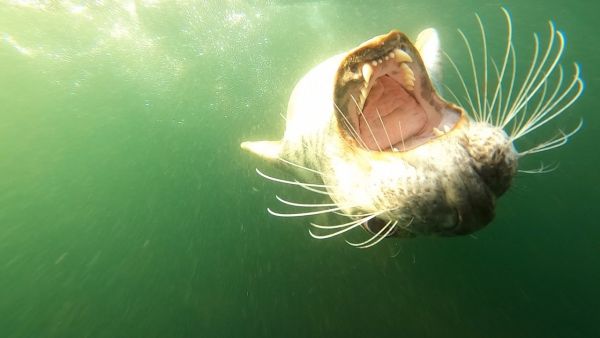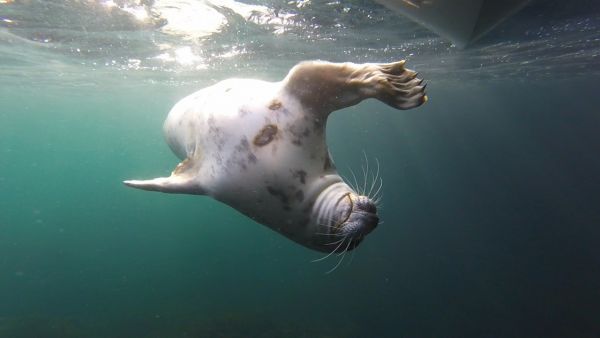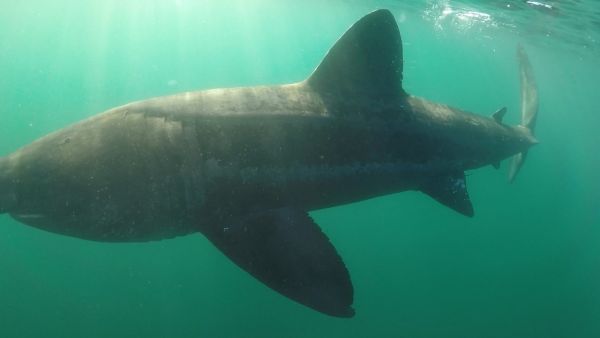Wildlife photographer and videographer Shane Stigant enjoys unique encounters with marine nature thanks to his hobby.
Shane shares videos he captures in Manx waters via his YouTube channel and, in a biodiversity crisis, he hopes they will lead to others acting for wildlife rather than just appreciating it.
Shane says his love of nature started at school. ‘I was always looking out of the window, longing to be outside, exploring. Now I’m most happy in a wild environment, whether it is the sea, a beach, river, woodland or open heath, so long as the influence of people is less obvious.
‘I enjoy watching the natural world but equally when I see it spoiled and degraded it makes me sad. When people say “isn’t it wonderful what great wildlife we have?” I think “isn’t it sad how we let it get so badly depleted and over exploited”.’

Shane received a camera from his parents for his 21st birthday and his skills have grown from there.
‘It was a film camera in those days and I learned a lot. I eventually got a medium-format camera and made prints in my own darkroom. The resolution was fantastic so when digital cameras came along with very limited resolution and needing an expensive computer to handle the files I didn’t take to it.
‘Now that the higher resolution digital cameras are more affordable I’ve taken the plunge and gone digital.
‘When I’m exploring the coastline by kayak, usually with my paddling buddy Craig Whalley, we carry small waterproof action cameras with us to record the interesting things we encounter.
‘These cameras are very handy, easily to use, can be put underwater, mounted under the kayak if necessary.
‘But when it comes to wildlife they are very limited. There is no control of the depth of focus and no zoom. If you paddle towards wildlife it tends to swim, fly or walk away so the only way, and best way, to get a good wildlife shot from a kayak is to sit tight and hope the wildlife choses to come to you.’

Shane shares his wildlife encounters with Manx Whale and Dolphin Watch.
But he laments the loss of species.
‘When I was much younger I used to see many more fish of all species,’ he said. ‘I just wish we had underwater cameras in my grandfather’s day so we would not just dismiss the yarns as fishermen’s tales.
‘If you see the old photographs of fish being landed many years ago, they really were bigger and much more plentiful.
‘I would urge anyone to read The Unnatural History Of The Sea by Professor Callum Roberts, then you will truly appreciate what I mean. Then grasp the concept of Shifting Baselines because what we have now is not normal, it is vastly depleted.’

Shane’s favourite moments in wildlife photography were probably around the year 2000 when there were lots of basking sharks in Manx waters.
‘I was possibly the first person in the world to photograph a newly born basking shark.’ he said. ‘I managed to take three photographs but I wish I had the movie cameras I have today.
‘Since then I've seen fewer basking sharks year on year and I’m hoping they have not gone for good.’
Shane added: ‘I am encouraged by the great work that DEFA is doing now, especially in Fisheries, but also now in land management. I hope I get to continue photographing and mark the return of biodiversity on land and sea.’
Shane’s top tips for photographing marine wildlife unobtrusively:
1. Do not approach wildlife - let it come to you.
2. Do not go anywhere near seal haul-out points, especially at low tide.
3. If a seal follows your kayak, paddle away from it - it could be a mother trying to protect its pup.
4. If the seal is still following you after observing point three, then stop and sit quietly. You are now hopefully far away from other seals who would rather not have your close to them. The seal that has followed you may be just inquisitive and may want to interact. Sit still and don’t make any sudden or threatening movements. Try lying back and lift your chin to the sky (offer your throat). Seals use a lot of body language and this one means you are submissive and are no threat (not to be confused with bottling or resting upright in the water). You may find the seal will do the same and even swim to you on its back. This posture appears to mean I want to play. Be careful and don’t be tempted to touch. Biting is part of seal play, too. They have very sharp teeth and their mouths are full of bacteria that your immune system probably hasn’t seen.


